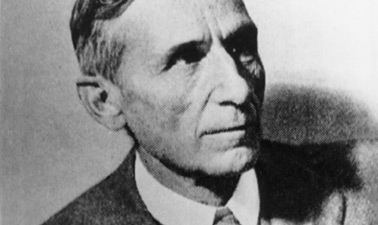Pompeu Fabra the man

The early years
Pompeu Fabra and the Catalan language
Fabra and sport
The late years
Pompeu Fabra i Poch was born on 20 February 1868 in the former village of Gràcia, specifically, on Carrer de la Mare de Déu de la Salut, today part of Barcelona. He was the youngest of 13 children born to Josep Fabra i Roca and Carolina Poch i Martí. Of all the siblings, however, only three – Pompeu and two sisters – reached adulthood.
In 1873, his father was elected mayor of the village of Gràcia. Three years later, the family moved to Barcelona. When he was just 20 years old, Fabra lost his father, a person who had greatly influenced him.
In 1902, Fabra married Dolors Mestre i Climent. They had three daughters: Carola (1904), Teresa (1908) and Dolors (1912). Fabra and his family lived in Bilbao for ten years. Upon returning to Catalonia, they settled in Badalona, where they remained for almost 30 years.
Pompeu Fabra and the Catalan language
Fabra earned a degree in chemical engineering from the Industrial School of Barcelona (1890) and held the Chemistry Chair at the Bilbao School of Industrial Engineers for ten years (beginning in 1902). Nevertheless, he was drawn to linguistics from the moment when, at the age of 15, he realized he did not know how to express himself in Catalan. He was trying to write a letter to his nephews. He started it, unconsciously, in Spanish, but did not get past the greeting…
His major contribution to Catalan grammar thus began, as a result of this realization, in the 1880s. It took form, in 1889, through his ties to the magazine L'Avenç. In 1890 and 1891, he promoted a memorable campaign for spelling reform, along with Jaume Massó and Joaquim Casas. Fabra’s main idea was clear: it was necessary to disseminate proper use of the Catalan language.
Founded in 1881, L’Avenç was originally devoted to literary, artistic and scientific advances. Indeed, its full name was L’Avenç Literari, Artístic i Científic: Revista mensual il·lustrada [Literary, Artistic and Scientific Progress: Illustrated Monthly Journal]. However, it later became a publishing house as well. In fact, it was considered the most important publisher in Catalan of its day, publishing up to seven magazines and more than 500 different books. As a publisher, L’Avenç moreover brought together a large group of writers and intellectuals with the common goal of undertaking cultural initiatives with a modernist approach. As a result, the institution would end up playing a decisive role in the evolution of contemporary language and literature. Fabra’s friends there, especially Massó and Casas, participated in his first important publications, whose primary aim was to lay the foundations for a profound spelling reform that would make it possible to put Catalan on an even footing with other languages of culture around it.
Separately, in 1911, Fabra founded the Philological Section of the IEC, which he headed from 1917 until 1948, following an initial stint by Antoni M. Alcover. Fabra also headed the IEC itself, intermittently, from 1921 to 1935. Additionally, he was a professor at the University of Barcelona and, when the university became the Autonomous University of Barcelona during the Spanish Republic (not to be confused with the present-day university of the same name), he chaired the Board of Trustees (1933).
Because of his position, and as a result of the events of October 1934, Fabra was imprisoned on the steamship Uruguay. However, his linguistic studies did not stop. He spent the six weeks and one day he was imprisoned on the ship preparing a talk on the evolution of words.
In addition to his engineering studies and his great passion for the Catalan language, Fabra was also a lover of sport. He became a member of the Centre Excursionista de Catalunya trekking association in 1891; he was a professional tennis player and member of the Futbol Club Barcelona tennis team; in 1914, he founded the Badalona Lawn-Tennis Club; he was president of the Catalan Tennis Federation from 1927 to 1935; from 1930 to 1935, he was also president of the national Catalan youth organization Palestra, which organized, amongst other activities, sport outings and competitions; and, finally, he was the first president of the Catalan Union of Sport Federations, today, the Union of Sport Federations of Catalonia (UFEC).
After the Spanish Civil War (1936-1939), Fabra went into exile in France. He entered the country through the Col du Perthus mountain pass, after spending the night at Mas Perxés, in the outskirts of Agullana in Alt Empordà. In France, he lived first in Illa, a Northern Catalan town in the Roussillon region and, then, in Paris, Montpellier and Perpignan. He spent the final years of his life in Prades, where he died on Christmas Day 1948. He is buried in the cemetery there, as is his daughter Teresa. Prades was also home to other famous exiles, such as Pau Casals, Josep Maria de Sagarra, Joan Alavedra and Francesc Pujols, amongst others.
Despite the adverse conditions in which Fabra lived out the final years of his life, before he died, he left a nearly completed new grammar of the Catalan language. It was published in 1956 by his colleague, Joan Coromines. Additionally, in 1945, he was awarded an honorary doctorate by the University of Toulouse.
In 1947, when he was 79 and, in fact, had little time left to live, Fabra sought to make a will. In order to do it in Catalan, he travelled to Sant Julià de Lòria, in Andorra, where, after a long and cumbersome trip, he was able to make his will in Catalan. The master thus gave a final lesson on integrity, consistency and fidelity to the Catalan language and nation.
